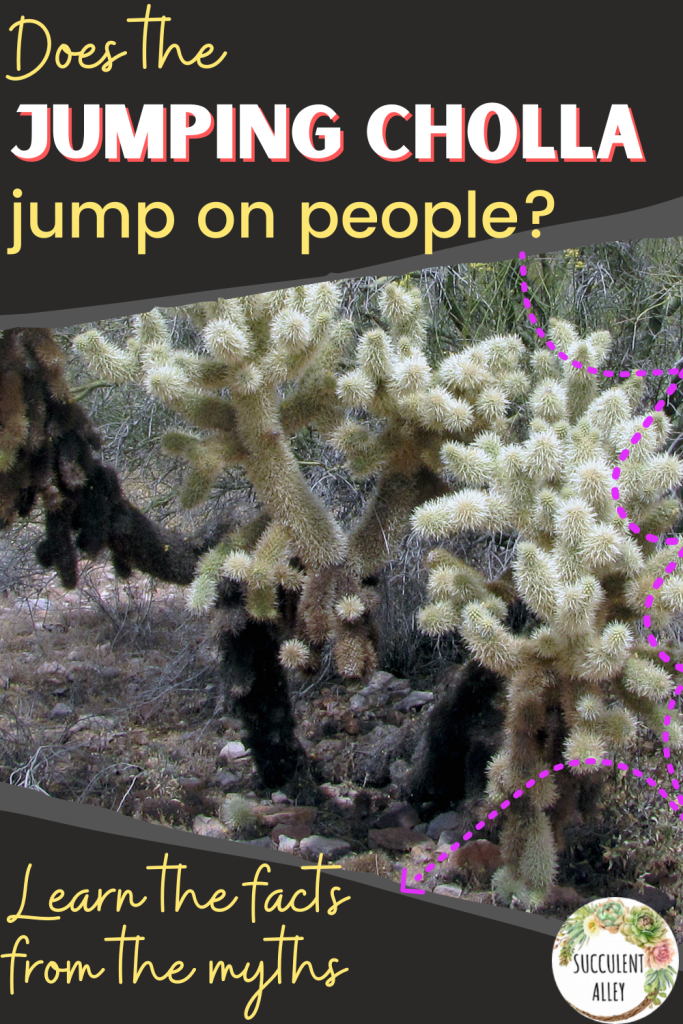Jumping Cholla TRUTH: The Cactus that Shoots Needles?
“Ouch!” “Help!” “Get this ____ off me!” are a few of the explicatives echoing on some of your favorite trails. That’s because of the jumping cholla cactus. More precisely, that’s because some innocent or unwary hiker has somehow touched, or was touched by, the spines of this grabby succulent.
Is there a cactus that shoots needles? Technically, thank heavens, no. But its fish-hook-like spines can attach themselves not only to your clothing and gear but to bare skin as well. Let’s look at some jumping cactus facts before we reveal its grabby secrets.
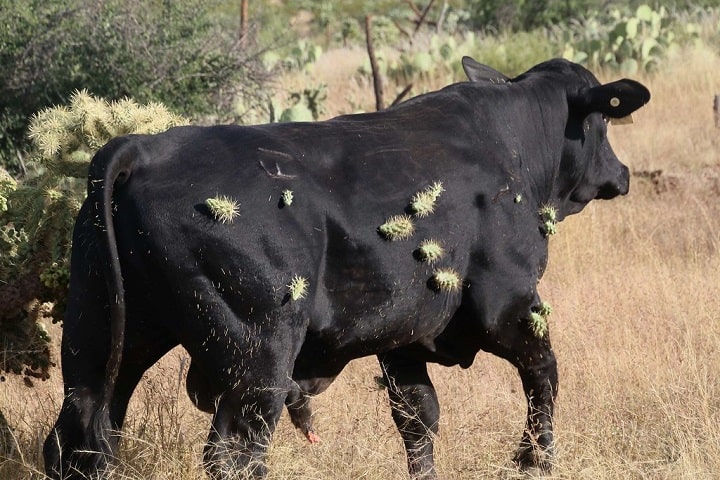
Contents
What is a Jumping Cactus?
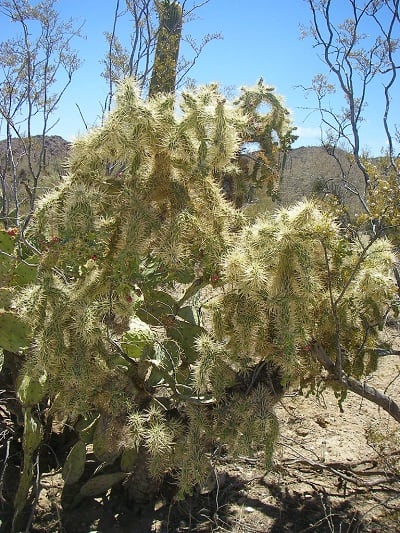
The chain fruit or jumping cholla has garnered the reputation of being capable of “jumping” from the ground or a parent cactus to a person’s clothing or skin. But don’t worry, the “cactus that shoots needles” does not actually jump or shoot needles.
It just quickly and easily detaches itself from the parent plant and hooks stubbornly onto (and sometimes into) people who venture too close or who happen to be near the plant when a strong breeze blows. This ability to attach itself easily is probably why people say it is a shooting cactus.
The cholla detaches easily as a way to survive. When a joint separates and then falls on the ground, it roots. So the plant spreads prolifically. If a person or animal manages to remove the spines after the joint has hitched a ride on fur or skin, the spines root where they fall to the ground, establishing a new location for the cactus.
It’s often easy for the chain-fruit cholla to catch people passing by because the mature plants’ barbed spines that grow close to long “chains” of fruit without spines that hang from the trunk. Some of these chains can be quite long.
When people stop to admire the fruit, they can easily contact the barbed spines that almost seem to jump at them. The jumping cholla’s spines are rather springy or bouncy, too, which makes them even more capable of hitching a ride on you.
Despite their nasty habit of attaching themselves to people, jumping chollas are some of the prettiest and largest in the desert. They can grow as tall as 15 feet with long chains on them, and they produce lovely pink and lavender flowers from late May and into June.
Irritations and Problems
The slightest touch often leaves parts of the cactus on clothing, which you then discover when you sit or lean in the wrong way. The fish-hook-like spines also grow only in one direction, which allows them to go deep into the skin. This may cause inflammation or discoloration, and eventually develop into an infection.
Fortunately, there’s no such thing as cholla cactus poison, and the teddy bear cactus is not poisonous. And the best news is that saltwater softens the spines, making them easier to remove. However, splinters can remain, sometimes for days or weeks. Uncomfortable but far from terminal.
Preventing Jumping Cholla Injuries
The best defense against a jumping cholla injury is a good offense. In other words, be prepared when you hike in these desert areas. Admire the plants but don’t get too close to them. Watch where you step — the spines on the ground can grab your clothing, shoes, socks, and bare skin.
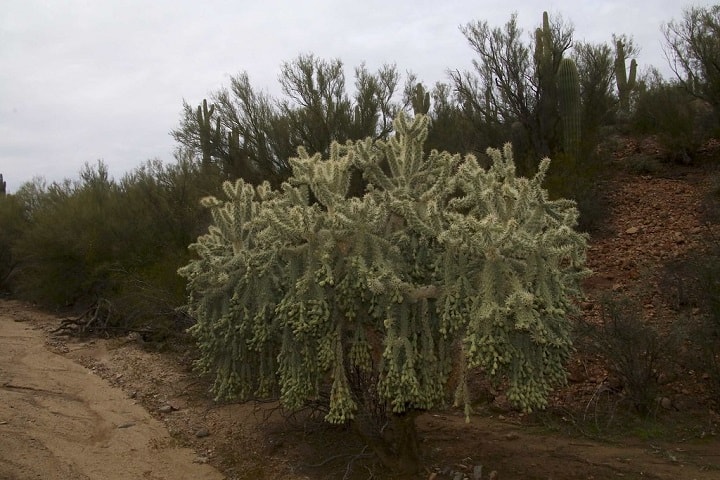
You may want to carry a large-tooth comb to pull the spines off your clothing or skin. You can also pack a forceps, which works great for pulling the spines free. In the absence of either of these, use a sturdy stick.
Chollas are a large genus of beautiful, tricky, unusual, and semi-dangerous cacti. As part of the natural desert world, they are here for our enjoyment and admiration. The key is not to get too close, and if you do, quickly and carefully remove any spines that may be attempting to propagate by riding on you or your clothing.
If you are aware of any potential hazards with jumping chollas and others of this group, you can navigate their habitat with little or no thought of discomfort.
About the Cholla Cactus
The cholla cactus (genus cylindropuntia) comprises 20+ species of plants with common names like buckhorn cholla, Arizona pencil cholla, walking stick cholla, and teddy bear cholla. They grow in the southwestern desert areas of North America and northern Mexico and are infamous for the barbed spines that attach to the fur of animals and the clothing and skin of humans.
Cholla refers to a variety of shrubby-looking cacti that have cylindrical stems made up of partitioned joints. The stems are, in reality, branches that perform a variety of functions, such as photosynthesis, producing flowers, and storing water.
The various species of cholla cacti—“the cactus that shoots needles”—have adapted themselves to the locales and elevations of the hot, southwestern deserts. Some of them propagate in high-elevation forests, others on the rocky, steep slopes of foothills. Most need coarse, well-drained soil.
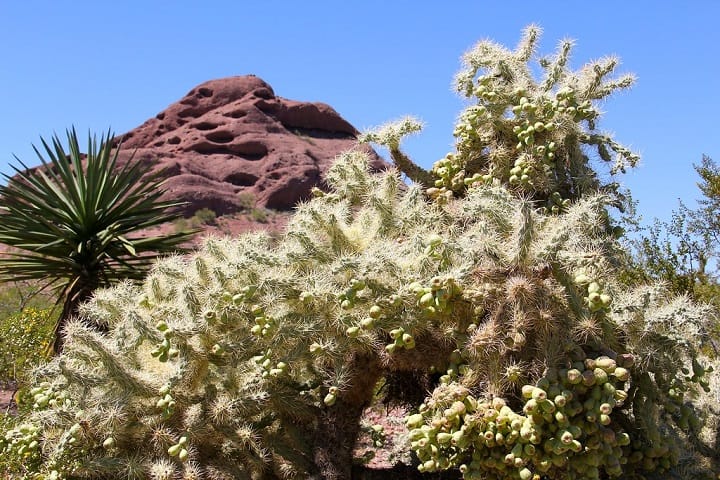
Many varieties bloom in April, May, or June; the month depends on the soil and weather conditions. They sport green/yellow or orange flowers, which can vary in color even within the same species. Joints and stems have different lengths, widths, colors, and shapes in addition to the varying numbers of spines that they have.
Chollas may grow as shrubs, trees, or ground plants and can be as short as 12 inches, for example, the devil and club chollas, and as high as the 15-foot chain-fruit cholla. Some species form extensive “forests” that cover many hectares.
Chollas are like most cacti: they have tubercles, which are little projections that resemble warts on the plant’s stems. This is where their prickly spines grow. The cholla is unique, though, because it’s the lone cactus with papery sheaths that cover the spines. In many chollas, the spines are colorful and bright, which gives this cactus its singular look.
This group of cacti is also unique due to clusters of tiny barbed spines known as glochids that grow just above the plant’s groups of regular spines. The glochids are red or yellow and easily detach from the pads or stems, and are hard to see and remove once they penetrate skin.
